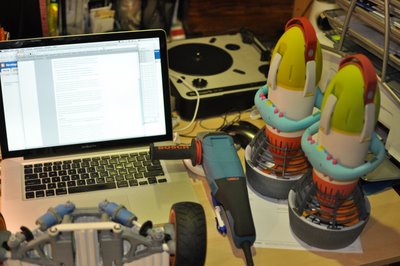I love the smell of bubblewrap, packing peanuts and prototypes in the morning (excuse the state of the desk – I’ve been travelling again).
A couple of weeks ago, Z Corporation announced a new composite material for its range of 3D printers, zp150. As ever, we’re keen to see what these new materials can do and how they perform with data we sent to the provider, rather than just relying on a material spec sheet and some stock photos.
The SeaDoo dataset (which is coloured like this due to a bug in SolidWorks) – the new model, in the new material does have a much richer colour set than the previous test (in the background).
Well, this morning, I was greated with a slightly baffled FedEx man looking for DEVELOP3D magazine – and of course, he was rather bemused to find it was in fact my front door. Key much banging around in the back of a van and signing of paper/electronic screens and I was presented with two very large boxes sealed up with Z Corp tape. Living, as I do, in a ridiculously small house, I decided to unbox the rapid prototype joy in the street, much to the hilarity of one of my particularly noisey neighbours (he and his wife sign their christmas cards “Les and Jess.” After eight years, we’ve yet to figure out which is which) as the packing foam decided to escape and make its way down the street. Still, after much running about and sweeping up, I was presented with three new RP models to add to my collection. Those that remember the Z540 try out, I had the same dataset built, another from Inventor (which never arrived last time) and Z Corp threw in a new model of an angle grinder. All of which have been packed up and shipped across from Z Corp’s headquarter in Boston.
Deeper blacks more vibrant colours. Seems to stack up for the new material
The results are good. The blurb for the zp150 material claims 40% increases in both ‘green’ strength (meaning when it’s fresh out of the build chamber) and when post processed using the standard infiltrant (which is cyanoacrylate or superglue to me and you). They also claim greater richness of colours, including brighter whites (which is key for architectural users) and deeper blacks). The models we’ve had built certainly back up the colour claims, but on opening two of the three models, the models were damaged – something which hasn’t happened before. I’m pretty sure this is down to the rather battered nature of the box when it arrived, but I did find it curious. If you build parts with a more stiff material, then this is going to happen and in all fairness, most prototypes built on an in-house machine don’t get shipped 4,000 miles, they’re built, played with, examined, tested maybe, kept if they’re good, or binned. The good news is that the models that arrived more accurately represent the colours of the data provided (we tested it using one of my favoutie devices – the Colour Cue – I’ve got an older one, but the new one does more), give you a better indication of design intent and let you get on with making decisions and progressing a design project.
Final Note: Another thing that my ’tests’ don’t really effect and that’s the fact that instead of the standard infiltrant, you can also use water to post cure and toughen up the model, rather than nasty chemicals – which is particularly useful for schools and other educational establishments (where the Z Corp machines have found a healthy home).










